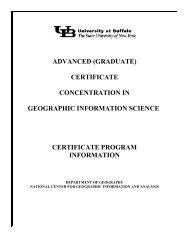Local Government GIS Demonstration Grant - NCGIA Buffalo
Local Government GIS Demonstration Grant - NCGIA Buffalo
Local Government GIS Demonstration Grant - NCGIA Buffalo
You also want an ePaper? Increase the reach of your titles
YUMPU automatically turns print PDFs into web optimized ePapers that Google loves.
Manager's Overview 3<br />
the activities directed toward the evaluation and selection of the <strong>GIS</strong> hardware and<br />
software may not need to be completed. One would simply use the same <strong>GIS</strong> system in<br />
use by the larger agency or group. Only the activities aimed at defining applications (uses)<br />
and identifying the needed data would need to be done by the smaller unit of government.<br />
In such a situation, the larger unit of government assumes the leadership role for the areawide<br />
<strong>GIS</strong> and should have the technical expertise to assist the smaller unit. In situations<br />
where a larger effort does not exist, a village or town government may want to look at a<br />
<strong>GIS</strong> installation in a similar village or town elsewhere in the state. Given the similarities in<br />
local governments within the state, the adoption of the <strong>GIS</strong> plan of another unit is not<br />
unreasonable. That plan should be carefully reviewed by the intended participants in the<br />
<strong>GIS</strong> to ensure applicability. After modifying and validating the plan, a schedule for <strong>GIS</strong><br />
hardware, software and data acquisition can be prepared consistent with available<br />
resources. If a good plan is prepared, there is no reason data acquisition (the most<br />
expensive part of a <strong>GIS</strong>) cannot be stretched over a long time period. Significant data<br />
already is available from state and federal agencies at reasonable costs. These data can<br />
form the initial <strong>GIS</strong> database, with locally generated data added later. A list of state and<br />
federal data sources is contained in the Survey of Available Data Guide.<br />
Content Of This Guide<br />
This guide presents an overview of the <strong>GIS</strong> development process. This process is presented as<br />
asequence of steps conducted in a specific order. Each step is important in itself, but<br />
moreimportantly, information needed to complete subsequent steps is assembled and organized in<br />
eachprevious step. The underlying philosophy of the entire series of documents is<br />
to concentrate on the <strong>GIS</strong> data. As well as being the most expensive part of any <strong>GIS</strong>, the<br />
data must be collected, stored, maintained, and archived under an integrated set of activities in<br />
order to ensure continued availability and utility to the initial users as well as future users,<br />
including the general public. Defining and documenting data elements from their initial definition<br />
in the needs assessment through to proper archiving of the <strong>GIS</strong> database according to state<br />
requirements is the constant theme of these guidelines.<br />
2 GEOGRAPHIC INFORMATION SYSTEMS: DEFINITIONS AND FEATURES<br />
Basic Definition Of A Geographic Information System (<strong>GIS</strong>)<br />
A geographic information system (<strong>GIS</strong>) may be defined as "...a computer-based<br />
informationsystem which attempts to capture, store, manipulate, analyze and display spatially<br />
referenced andassociated tabular attribute data, for solving complex research, planning and<br />
management problems"(Fischer and Nijkamp, 1992). <strong>GIS</strong>s have taken advantage of rapid<br />
developments inmicroprocessor technology over the past several decades to address the special<br />
challenges of storingand analyzing spatial data. Geographers have referred to <strong>GIS</strong>s as<br />
simultaneously providing "...thetelescope, the microscope, the computer and the Xerox machine"<br />
for geographic and regionalanalysis (Abler, 1987).




